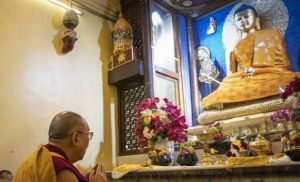
Siddham, according to Prof. Wang Bangwei of Peking University, refers to a specific type of script used in ancient India; in China, it refers more broadly to the study of Sanskrit, in particular, the linguistic science of Sanskrit, or śabdavidyā. As Buddhism was spread from India to China, Indian and Central Asian languages were too introduced to the Chinese. During the time when Chinese Buddhist translation reached its maturity, that is, from the Wei Jin Period to the Tang Dynasty (c. 4th – 9th century), many important Buddhist texts were imported into China through the missionaries. It so happened that the Siddham scripts were used during that period and as a result of the Chinese emphasis on writing as opposed to the sound, Siddham was given particular importance as a basic form of study required to understand Sanskrit. Subsequently, the study of Siddham developed into an indigenous school devoted to understanding various aspect of Siddham, including the way the script works, pronunciation and doctrinal imports.
Subsequent to Northern Song, as Buddhism in China became progressively indigenized, the study of Sanskrit, along with Siddham the foreign script, lost its appeal to the Chinese Buddhists. Despite attempt of revival (for example, Zhao Huanguang’s (1559-1625) treatise on Siddham, Xitanjingzhuan, as noted by Prof. Jao Tsung-I), the great learning of Siddham of the Tang Dynasty was essentially lost in mainland China, but was carried on in Japan. Since Siddham studies were brought to Japan by Kūkai and Saichō in the early 9th century, the learning had continued to blossom to this date, with lineage in both the Shingon and Tendai schools. As Siddham writing has a wide range of application in both esoteric and exoteric Buddhism, including various meditational practices, rituals and so on, Siddham characters have characterized Japanese Buddhism and have become ubiquitous in Japan even today.
A visit to Japan for those who recognize the Siddham characters would turn out to be particularly fruitful as they are not only everywhere but they carry special meanings to the objects which bear them. Foreign and curious these characters may look to the undiscerning eyes, they are not only the key to understanding an essential aspect of Japanese Buddhism, but are also a window through which one may catch a glimpse of what Buddhism in ancient China was like during its most glorious time during the Tang Dynasty.
In this photo-journal, I hope to bring readers through different places in China and Japan where these sacred characters are found. The ancient Sanskrit characters, though no longer used in India and would appear completely foreign to most Indian as to Chinese, nevertheless tell extraordinary stories of great historical and cultural interest. They are a testimony of the discourse between the two ancient cultures – China and India.











